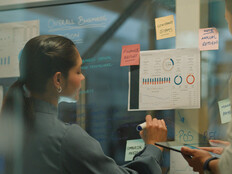Schools Showcase Ways to Maintain STEM Program Funding
Carrie Shaver watched with pride as her son, Cole, walked to the front of the cafeteria to collect his honor roll certificate. Eventually, she realized that just about every kid in the room had made honor roll and scored above average on the California Standards Test. "It took forever," she recalls. "The bell rang, and they were still calling names." Not that anyone was complaining.
The students' achievements serve as a testament to the work that the entire community has put into creating the STEM Academy, a unique curriculum at Discovery School, the sole K–8 institution in California's 19-school Lancaster School District.
Since 2009 — when President Obama announced his "Educate to Innovate" campaign to improve science and math education through challenges to communities and support from the government and industry — a growing number of districts have launched successful science, technology, engineering and mathematics programs. But creating such programs isn't easy. They require an all-hands-on-deck effort. Ample resources are available, from volunteers and equipment donations to billions in public and private grant dollars; the trick lies in figuring out how to tap these resources.
"STEM is the focus du jour," says Dr. Jennifer House, president and principal of RedRock Reports, an education-funding consultancy in Menlo Park, Calif. There are a lot of STEM grants available, but they're competitive (see sidebar, "Grants Galore"). House suggests starting with the money that districts have access to automatically, such as Title I and Individuals with Disabilities Education Act (IDEA) funds. Although schools can't devote these sources entirely to STEM, they can apply portions to these programs, and the money can add up quickly.
The next logical step is to identify potential state and local resources, House recommends. The push to improve the nation's STEM performance — American students ranked 23rd in math and 31st in science among students from 66 industrial nations in the Organization for Economic Cooperation and Development's latest Program for International Student Assessment exam — has made funding plentiful. "We aren't cutting it," she says. "It's embarrassing. Everybody's got a stake in trying to turn that around."
Efforts by Lancaster and two other districts — Akron Public Schools in Ohio and Brandywine School District in Claymont, Del. — provide model examples for setting fundraising plans, identifying likely funding sources and making the transition from program launch funds to long-term resources.
Show, Don't Tell
Cole Shaver is building a robot. He's done some programming with Lego robotics, but "it was nothing compared with this," he says. Students like Cole are valuable resources when it comes to fundraising by the Lancaster School District. "They're so excited, and they want to learn more," Deputy Superintendent Michele Bowers says. "You want to do more as a teacher, as an administrator, as a community member."
By exposing businesses to its students, Lancaster has created partnerships with Lockheed Martin, Northrop Grumman and the Air Force Research Laboratory at Edwards Air Force Base. NASA sends employees to serve as mentors, and they bring high-tech equipment for classroom activities. Students even go on field trips to Edwards AFB to meet engineers.
Although a lot of people and organizations expressed willingness to help, many initially didn't know how, Bowers points out. "They had never been asked." Now, when she sends letters to the community and speaks at engagements, Bowers offers concrete examples of the district's needs. But it's important to develop a strong program before asking for help. "It's hard for people to commit to something that doesn't exist," she says, noting that districts should devote at least a year to planning. Some of the questions to consider include: How many students will the program serve? What does it need to get off the ground? What are the core principles? What are the goals for graduates?
The Lancaster School District has an advantage because many of the solar-power companies moving to the area support the STEM curriculum in the hope that students will eventually become employees. Bowers also recommends working with local government agencies for the same reason, noting the avid support that Edwards AFB has provided. "They're looking for the engineers of tomorrow," she says. "They're getting kids excited about engineering in middle school."
The Air Force Research Laboratory on the base used funds from the American Recovery and Reinvestment Act to purchase high-end Lenovo notebooks with AutoCAD for the school's one-to-one computer program. Students have been using them for various projects, including a recent one to create playground equipment with solar-powered lighting.
"I can't stress the partnerships enough," Bowers continues. "By networking, we find out where the resources are. There's always room for one more."
Embrace Local Resources
When Akron Public Schools set out to open a STEM middle school in fall 2008, Superintendent of Schools David W. James recalls that he encountered "a lot of doubters who thought, 'It's not going to open on time.' "
Establishing a STEM high school, which Akron will open this fall, proved even more challenging because of the economy. But with help from the city, the University of Akron and private business partners, James says, "We'll have everything we need to have it up and running. We always do."
In fact, he plans to soon collect a $10,000 check from The Dominion Foundation, which will go toward a matching grant from the GAR Foundation. The OMNOVA Solutions Foundation gave $150,000, and other donations have been pouring in as well, James says.
The STEM middle school was the result of a collaboration between the city, the district, the University of Akron and the National Inventors Hall of Fame. In 2005, when the district undertook major building renovations funded by the city and state, it won a state STEM grant to open a new middle school.
At the same time, the private Inventors Hall of Fame museum in Akron was struggling financially and looking for someone to take over tenancy of its city-owned building. After discussions among multiple parties, the district decided to build an addition to the museum building and convert it to the National Inventors Hall of Fame School … Center for STEM Learning (NIHF–STEM).
Akron Public Schools also has forged a strong partnership with the University of Akron. Its new STEM High School will be located in a district building next to the UA campus. The university will run some programs there, and high school students will be able to take college-level courses.
"You really have to be creative," says Traci J. Buckner, NIHF–STEM instructional leader (a role commonly known as principal). "Don't limit yourself to your building. You never know what someone [in the community] will be willing to offer. We can always pick up the phone and call someone, and if they don't know, they can call someone else."
Plan to Go the Distance
When Brandywine School District students took their PSATs and SATs in 2011, more than half identified STEM fields among their career interests. Even those who marked non-STEM careers might need STEM skills, however. That's why district leaders chose to embed a STEM curriculum in all of its schools.
The district's curriculum relies on a four-year Race to the Top grant, which doesn't allow for a lot of time to make such an all-encompassing program sustainable, says Judson Wagner, STEM program manager for Brandywine. "We learned a lot the first two years," he says. "But the grant runs out in two more years."
This spring, Claymont residents approved a tax increase referendum to expand upon what the district created with its Race to the Top grant. Businesses and schools from across Delaware also have been pitching in, says Wagner, who also serves as co-chairman of the state's STEM Council. The council is putting together a statewide coalition that will let businesses pool their resources in support of STEM projects. That way, districts won't have to rely too heavily on single grants.
The state needed an approach that could "weather the economic storm," Wagner says. "If a partnering company moves out of state, another one can step in to fill the void. It's exciting to see how much interest there is from all areas."
Grants Galore
Public, private, local, national, big and small grants abound for science, technology, engineering and math initiatives. Here's just a sampling of STEM grant options, courtesy of education-funding consultancy RedRock Reports:
- 21st Century Community Learning Centers
- Advanced Placement Incentive Program (DOE)
- American Honda Foundation
- Amgen Foundation
- Bill & Melinda Gates Foundation
- Carnegie Corp. of New York
- Charter Schools Program State Educational Agencies (DOE)
- GenCorp Foundation
- Investing in Innovation Fund (DOE)
- Microsoft class action settlement vouchers (still available in some states)
- Race to the Top Fund (DOE)
- School Improvement Grants (DOE)
Besides these, Dr. Jennifer House, RedRock's president and principal, recommends that districts check with local business roundtables, chambers of commerce and service organizations such as Rotary and Kiwanis to see what grants they might be able to provide. She also suggests Grant Wrangler for researching small grants. Michele Bowers, deputy superintendent for the Lancaster (Calif.) School District, suggests looking for possible resources through STEM Grants.








